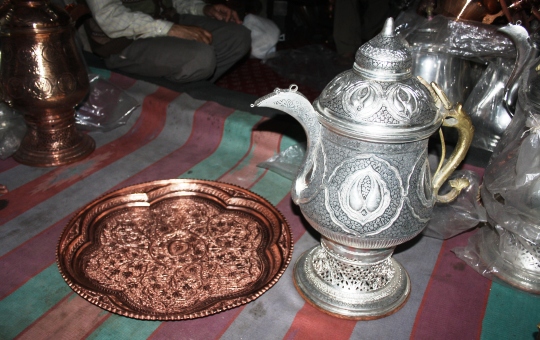
Even though the beating looks haphazard it is important in this job, the more the beating the better the work. Syed Asma reports.
This is how most of the copper utensils have to go through at the hands of copper smiths before emerging into different cookware and utility items.
The coppersmiths in Kashmir have been into the trade for centuries. Almost all the work is done by hand and involves several processes from beating of sheets to polishing on lathe, and coating with a thin coat of tin.
Muhammad Yousuf Kakroo of Kawadara a tall, slender, gray-haired coppersmith in mid-sixties makes hand-made copperware, that later adorn the shops mostly located in old city. His physique does not seem to be fit for the tough job, which needs a lot of muscle besides a good brain.
At a casual glance his shop seems a bit rugged with metal scarps and tools scattered all over the place which also has a small furnace.
The process according to Kakroo begins with finding the right sheet that fits the utensil that is to be made. A worker’s mind goes through a thought process of what has to be done and all this is translated into indentions on the copper sheet using a variety of hammers. These are the tools that are used from carving out rough shapes on metal sheets.
Interestingly, wooden hammers are initially used and are of great significance as these work very well with the metal, before iron hammers are used to fine tune the product with slow targeted pounding. Finally the copperware is polished on a lathe.
Kakroo is not alone in his shop and a few other master coppersmiths make up his staff, as the process is not a one man job. The work here involves a team.
About the uniqueness of this metal, Kakroo says that it is soft and its good heating properties makes it best suited for of all kitchen cookware.
The introduction of introduce engraved (Nakshi or Kandakari) copperware, people associated with the trade say, could be linked to silversmiths joining this trade. The engraved wares are in high demand today, with various floral designs being the most popular ones. Besides floral designs, persian couplets in calligraphy is either engraved or embossed on copper with a pattern called Islimi being one of the best design works.
But some state that engraving on copper is very old and one finds that coins of copper did have detailed engravings. Many families that are still in copper business still share their “castes” with that of goldsmiths here.
The trade and artisans are mostly confined to old city areas with many working in small units set up in their homes, though some people in rural areas have ventured into the trade.
The main markets exist in Srinagar city with markets at Zainakadal, Nowhatta, Sarafkadal and along Nallahmar stretch frequented by customers. Both plain and engraved copper is in demand and caters to the differing tastes of buyers.
Many kitchens in Kashmir still use Copperware. Utensils like plates, spoons, samovar, jugs, trays and pots are in high demand.
Copperware in the family is passed on with heredity, and many families can be seen using copperware which passed on to them from their ancestors. Some people even purchase copperware as an investment. A large number of families give copperware to their daughters as part of the dowry.
The ornamental engraved copper items are mostly exported, or find its way to drawing rooms in Kashmir.















